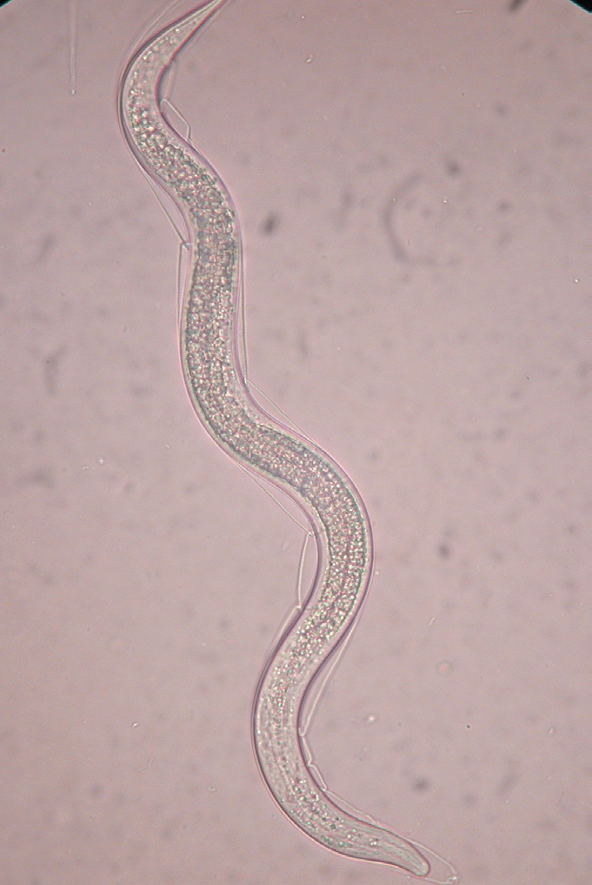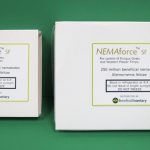
Nematodes are released in their infective juvenile stage to search out and enter insect pests. Once inside, the nematodes release symbiotic bacteria that quickly kill targeted insects. Reproduction inside the insect releases new generations of infective juvenile nematodes that disperse in search of further prey.
The active ingredient in NEMAforce™ SF, Steinernema feltiae, quickly controls larval stages of fungus gnats (Bradysia spp.), and the adult and pupal stages of western flower thrips (Frankliniella occidentalis). When applied to the soil, S.feltiae will provide prolonged protection against pest re-infestation. NEMAforce™ SF is ideally suited for use in integrated pest management programs as an important tool for resistance management, worker safety and environmental responsibility.
Fungus Gnat Biology and Life Cycle
Adult fungus gnats are small (1/8 inch long), black-gray flies with long legs, many segmented antennae and a single pair of grayish transparent wings with a Y-shaped vein near the wing tip. Adults are weak fliers and often found near light sources or along the soil surface. Females deposit up to 200 eggs individually or in clusters where fungus is growing. Eggs hatch in 3-6 days, depending on temperature, and will then go through four larval instars. Larvae are about ¼ inch long and are translucent, legless and worm-like, with a distinctive shiny black head. Larvae usually are concentrated in the top 1-3 inches of the soil, but can be found throughout the soil profile. Larvae will feed for about 2 weeks before pupating in a cocoon near the soil surface. After 3-7 days the adult will emerge and live for around 8 days. Development from an egg to adult occurs in 3-4 weeks with multiple, overlapping generations per year as long as conditions are warm enough for reproduction. Optimal temperature for development is around 70-75 °F (21-24 °C). Fungus gnats will overwinter as cocooned larvae in protected areas or organic matter.
Fungus Gnat Damage
Fungus gnat larvae prefer to eat fungus, which is needed in their diet for optimal development, and reproduction. However, if fungus is not readily available, larvae will feed on plant material. Larval feeding can cause direct root damage, as well as provide an entry into the roots for fungal pathogens like Thielaviopsis, Pythium, Botrytis, Verticillium, and Fusarium.
Larvae and adults also may transmit fungal plant diseases through excretion or by carrying spores on their bodies as they move from plant to plant. Fungus gnat larvae tunnel into thick, succulent stems and roots, causing the plant to wilt and in severe infestations die. Seedlings, young plants and unrooted cuttings lacking fully developed root systems are particularly vulnerable to larvae. Larvae feeding on unrooted cuttings will interfere with callus formations and may slow or completely inhibit root initiation.
Monitoring greenhouse areas for fungus gnat infestations is important because early detection is key to maximize control of the pest. Monitor adults with yellow sticky cards placed horizontally at the soil surface or vertically just above the canopy. To monitor larvae, place potato slices (1 inch thick) on the surface of the soil. Check and replace the slices weekly recording the numbers of larvae found on the potato slices and on the soil just beneath the slices. Tolerance levels will depend on the crop and stage of growth; contact your local extension agent for tolerance levels
Application Details
Fungus gnat larvae can be controlled with NEMAforce™ SF by making frequent, light applications (50 million/1100 ft² [100 m²]) or less frequent applications at higher rates (50 million/550 ft² [50 m²]). Application interval selected should be based on grower preference, management program, and crop growth characteristics. Regardless of interval selected, applications of NEMAforce™ SF should begin early in the growth cycle. Apply in a sufficient volume of water to thoroughly soak the soil but not beyond the point where water overflows or leaches from pots, typically 30-50 gallons/1000 ft² (115-190 L/100 m²).
Applications of S.feltiae should be made to moist soil and applied in the early morning or late evening to avoid high temperatures and nematode desiccation. Remove all sprayer filters of 50 mesh or finer and maintain pump pressure below 300 psi to avoid damaging nematodes. If NEMAforce™ SF is applied over foliage, irrigate immediately with plain water to wash nematodes into the soil. Soil temperatures should be between 50-86 °F (10-30 °C).

